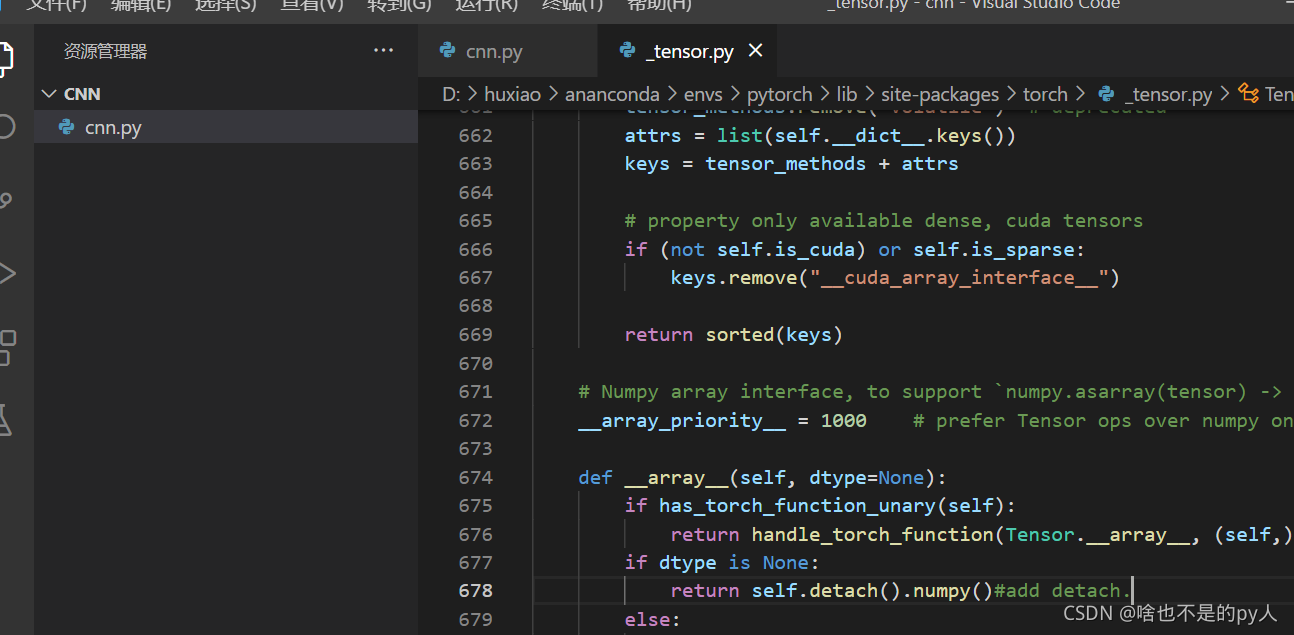Note; a detech was added to line 678 of _tensor.py when debug was changed

import torch
from torch.utils import data # 获取迭代数据
from torch.autograd import Variable # 获取变量
import torchvision
from torchvision.datasets import mnist # 获取数据集
import matplotlib.pyplot as plt
# 数据集的预处理
data_tf = torchvision.transforms.Compose(
[
torchvision.transforms.ToTensor(),
torchvision.transforms.Normalize([0.5],[0.5])
]
)
data_path = r'D:\Machinelearning\data'
# 获取数据集
train_data = mnist.MNIST(data_path,train=True,transform=data_tf,download=True)
test_data = mnist.MNIST(data_path,train=False,transform=data_tf,download=True)
train_loader = data.DataLoader(train_data,batch_size=128,shuffle=True)
test_loader = data.DataLoader(test_data,batch_size=100,shuffle=True)
# 定义网络结构
class CNNnet(torch.nn.Module):
def __init__(self):
super(CNNnet,self).__init__()
self.conv1 = torch.nn.Sequential(
torch.nn.Conv2d(in_channels=1,
out_channels=16,
kernel_size=3,
stride=2,
padding=1),
torch.nn.BatchNorm2d(16),
torch.nn.ReLU()
)
self.conv2 = torch.nn.Sequential(
torch.nn.Conv2d(16,32,3,2,1),
torch.nn.BatchNorm2d(32),
torch.nn.ReLU()
)
self.conv3 = torch.nn.Sequential(
torch.nn.Conv2d(32,64,3,2,1),
torch.nn.BatchNorm2d(64),
torch.nn.ReLU()
)
self.conv4 = torch.nn.Sequential(
torch.nn.Conv2d(64,64,2,2,0),
torch.nn.BatchNorm2d(64),
torch.nn.ReLU()
)
self.mlp1 = torch.nn.Linear(2*2*64,100)
self.mlp2 = torch.nn.Linear(100,10)
def forward(self, x):
x = self.conv1(x)
x = self.conv2(x)
x = self.conv3(x)
x = self.conv4(x)
x = self.mlp1(x.view(x.size(0),-1))
x = self.mlp2(x)
return x
model = CNNnet()
print(model)
loss_func = torch.nn.CrossEntropyLoss()
opt = torch.optim.Adam(model.parameters(),lr=0.001)
loss_count = []
for epoch in range(2):
for i,(x,y) in enumerate(train_loader):
batch_x = Variable(x) # torch.Size([128, 1, 28, 28])
batch_y = Variable(y) # torch.Size([128])
# 获取最后输出
out = model(batch_x) # torch.Size([128,10])
# 获取损失
loss = loss_func(out,batch_y)
# 使用优化器优化损失
opt.zero_grad() # 清空上一步残余更新参数值
loss.backward() # 误差反向传播,计算参数更新值
opt.step() # 将参数更新值施加到net的parmeters上
if i%20 == 0:
loss_count.append(loss)
print('{}:\t'.format(i), loss.item())
#torch.save(model,r'D:\Machinelearning\model\cnn')
if i % 100 == 0:
for a,b in test_loader:
test_x = Variable(a)
test_y = Variable(b)
out = model(test_x)
# print('test_out:\t',torch.max(out,1)[1])
# print('test_y:\t',test_y)
accuracy = torch.max(out,1)[1].numpy() == test_y.numpy()
print('accuracy:\t',accuracy.mean())
break
plt.figure('PyTorch_CNN_Loss')
plt.plot(loss_count,label='Loss')
plt.legend()
plt.show()output
